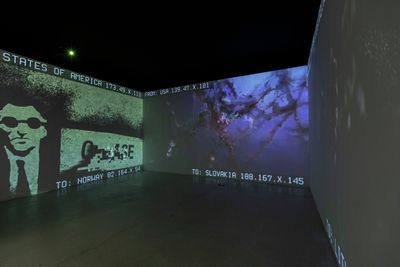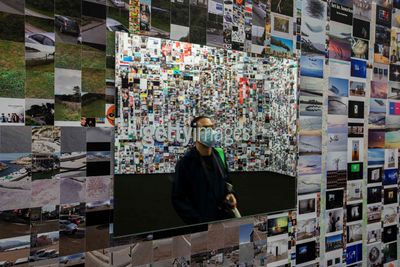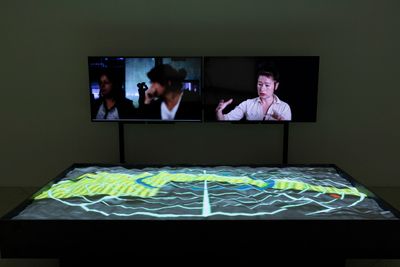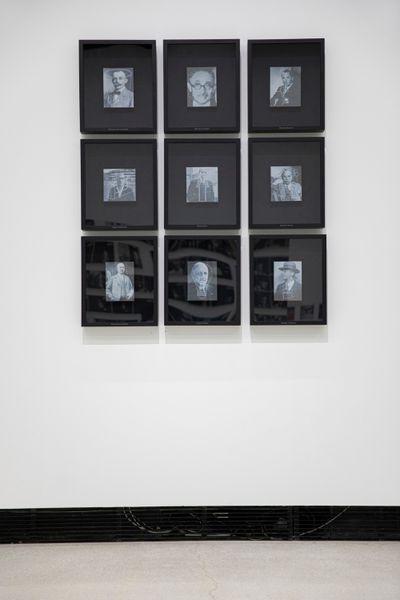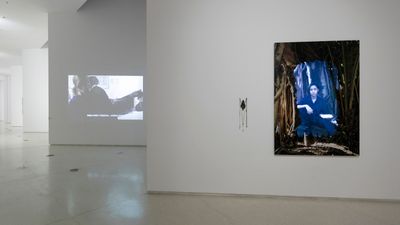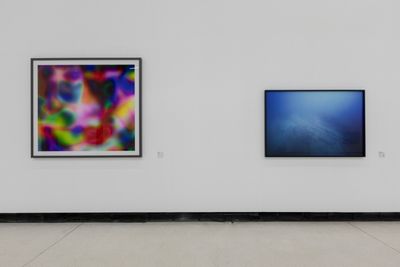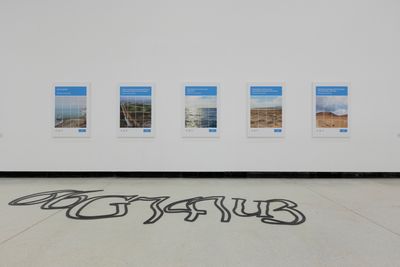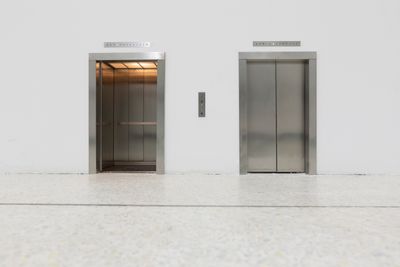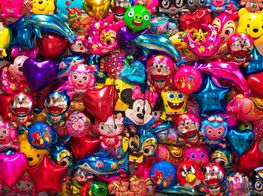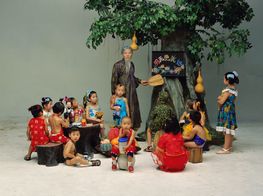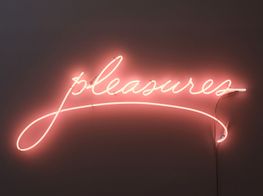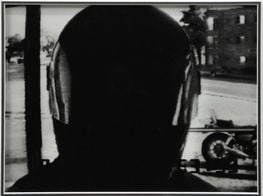A Supermarket of Images Tracks the ‘Iconomy’ of Online Pictures

Sylvie Fleury, ELA 75/K (Won't Smudge Off) (2000); Samuel Bianchini, Visible Hand (2016). Exhibition view: Le supermarché des images, Red Brick Art Museum, Beijing (29 May–1 August 2021). Courtesy Red Brick Art Museum.
At the Techonomy conference in 2010, Google CEO Eric Schmidt famously said, 'There were five exabytes of information created between the dawn of civilization through [to] 2003, but that much information is now created every two days.'1
A hyperbolic claim repeated more often than it can be debunked, it nevertheless underscores the ubiquity of technology today. By one estimate, more than 3 billion images are shared and seen on social media each day,2 with the average internet user spending approximately two and a half hours per day scanning their social networks.3
More than just a digital revolution, the online avalanche of information has changed the way people think about images: what we do with them, and how we take, store, and distribute them.
Le Supermarché des Images (The Supermarket of Images) at the Red Brick Art Musem, Beijing (29 May–1 August 2021) takes this saturation of images and its various implications as its subject, considering the more prosaic matter of information management—transmission, storage, data extraction—in keeping with the concept of iconomy, developed in curator Peter Szendy's 2017 book The Supermarket of the Visible: Towards a General Economy of Images.
Introducing Szendy's premise is Samuel Bianchini's Visible Hand (2016), an ever-changing image of a hand composed of ASCII characters, with numerals and letters moving continuously in conjunction with the vagaries of the stock market.
The constantly shifting text alludes to the confluence of image, finance, and information, while also parodying Adam Smith's fanciful notion of markets kept in balance by an invisible hand. It feels especially relevant at a moment when, on the U.S. stock market, about 70–80 percent of overall trading volume is generated through algorithmic trading, uninterrupted by human agency.
One of the most visually striking works in the show, is Evan Roth's Since You Were Born (2019–2021), which fills a cavernous room with every image that Roth has browsed online since the birth of his second child in 2019: family photographs, website logos, travel shots, artworks by other artists, and more.
An unintended issue that arises when viewing Roth's work in a Chinese context, however, is the role of censorship: every work in an exhibition on view in China must be approved, including the content of every image. To imagine the effort involved in getting Roth's work approved for this exhibition is as overwhelming as the resulting installation.
The rest of the exhibition is arranged into five thematic propositions: Stocks, Raw Materials, Work, Values, and Exchanges, reflected through a colour-coding system presented on wall labels. The artworks themselves, however, are situated according to the pragmatics of the space rather than clustered by topic, prompting the viewer to constantly check the colour on each label, making for a slightly awkward experience. (One quickly forgets about keeping tabs with the themes.)
...wandering this show makes for an entertaining, enlightening, and often troubling afternoon.
Nevertheless, wandering this show makes for an entertaining, enlightening, and often troubling afternoon. Fitting into any one of the exhibition's topics is Labour in a Single Shot (2011–ongoing) a collaborative series of two-minute videos by Harun Farocki and Antje Ehmann showing different forms of labour around the world, from dentistry to the daily activities of a Lenin impersonator in Moscow's Red Square, highlighting in equal amounts the mundanity, toil, and perversity of work in the 21st century.
Martin Le Chevallier's video Clickworkers (2017) explores the darker side of the digital economy. Featuring seemingly innocuous still images of domestic interiors overlaid with the verbal testimony of seven low-paid, human monitors who ensure that a Facebook experience is a sanitary one.
Usually operated by young women in underdeveloped countries working long hours to scour the internet and scrub it clean—watching hours of sex tapes, child exploitation, and beheadings in the process—their labour extends to liking, tagging, trolling, and subtly manufacturing opinions, ubiquitous yet invisible.
Mining similar territory is Lauren Huret's gris-gris pour les yeux and Portrait en Sainte Lucie (Lesley Ann-Cao) (both 2019), which refer to the lived realities of Filipino internet censors. With its large population of tech-literate, English-speaking, and low-wage labour, the Philippines is host to a sizeable number of content moderators employed by the likes of Facebook and Instagram.
Working at a rate of a mere eight seconds per image, Huret depicts these moderators as modern martyrs, personally digesting the world's visual sins to keep the rest of us from harm.
Huret's modern interpretation of Saint Lucie—fittingly the patron saint of the blind, writers, labourers, and of the Philippines—features the visage of one such content moderator that she met in Manila, carrying a dish in which rests two blinking eyes, in reference to the sacrifice of both the saint and the Filipino tech workers.
Gris-gris pour les yeux takes the form of an icon of the Virgin Mary draped with a rosary featuring miniature charms of laptops and eyeballs, as a sort of talisman against the ills of the images the predominantly Catholic Filipino 'cleaners', must absorb.
Of course, in the iconomy, some forms of digital labour have been covertly distributed among the general populace. Aram Bartholl's Are you human? (2017), an installation of photographs of CAPTCHAs, references one such instance in the form of the now ubiquitous and much maligned image puzzle that websites use to verify whether a real human is behind certain interactions.
In reality, while we click on squares identifying road signs, traffic lights, and pedestrian crossings, we are training pattern recognition software for self-driving vehicles and surveillance technology. Randomly generated and designed to exist only in the moment, Bartholl captured them and prints large-format photographs, or renders in steel, making concrete what was designed to be fleeting.
Striking a more whimsical note, three photographs by Liu Bolin from the artist's 'Hiding in the City' series—Mobile Phone (2012), Screens in Rest (2017), and The Inheritance of Color and Mask (2016)—see Liu made up by a team of painters and make-up artists so that he disappears against a chosen background. Though the connection with images is less clear in Maurizio Cattelan's Untitled (2001), a set of functioning miniature elevator doors reminiscent of those found in department stores.
Cattelan's installation charts the niche history of the elevator and its intimate links with labour, commerce, and power, dating back some two thousand years as a tool for hauling material out of pit mines, with the first personal elevator installed in the Palace of Versailles in 1743 connecting the apartment of King Louis XV with that of his mistress, Madame de Chateauroux.
One of the risks of staging an exhibition that relates to the present moment is that the present is never still, making the absence of works relating to the latest online phenomenon, NFTs, or non-fungible token-based works, all the more conspicuous, save for the inclusion of conceptual artist Kevin Abosch's IAMA COIN Project (2018), in which he created ten million tokens on the Ethereum blockchain.
Abosch considers each token as a virtual artwork, the address of which he then had printed in his own blood on paper, several thousand of which are kept in sacks, their key lost, thus rendering them inaccessible and worthless. By drawing a string between his own body, the blockchain, and the notion of value as little more than social agreement, Abosch raises multiple questions about the valuation of artistic labour and art as an asset class.
If the exhibition suffers at all it is that each of the themes being explored could easily make for an exhibition in itself, so the works representing each topic can feel too few—an entire section could have been added on NFTs alone.
Also—and perhaps unsurprising since this show was originally developed for a French institution—the artist list is noticeably Eurocentric, with only three representatives from Greater China, Liu Bolin, Li Hao, and Wang Qingsong, leading to a long list of notable omissions. —[O]
1 Robert J. Moore, 'Eric Schmidt's "5 Exabytes" Quote is a Load of Crap', The Data Point, 7 February 2011, https://blog.rjmetrics.com/2011/02/07/eric-schmidts-5-exabytes-quote-is-a-load-of-crap/
2 T.J. Thomson, Daniel Angus, and Paula Dootson, '3.2 billion images and 720,000 hours of video are shared online daily. Can you sort real from fake?', The Conversation, 3 November 2020, https://theconversation.com/3-2-billion-images-and-720-000-hours-of-video-are-shared-online-daily-can-you-sort-real-from-fake-148630
3 Kit Smith, '126 Amazing Social Media Statistics and Facts', Brandwatch, 30 December 2019, https://www.brandwatch.com/blog/amazing-social-media-statistics-and-facts/


